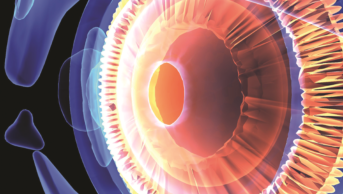
Shutterstock.com
Learning outcomes
At the end of this case study, you will be able to:
- Describe the pathophysiology, signs and presentation of wet age-related macular degeneration (wet AMD);
- Outline the role of vascular endothelial growth factor (VEGF) inhibitors in the treatment of wet AMD, their mechanism of action and potential adverse effects;
- Describe why intravitreal injections are the most suitable drug delivery route for the treatment of wet AMD and outline the limitations of the other drug delivery routes;
- Outline the pharmaceutical considerations in the design of intraocular preparations.
Mrs RT is 68 years old and has been noticing a change in her vision over the past couple of months. She can no longer read small print, even with her usual reading glasses. There is always a slight smudge in her sight and lines always appear wavy rather than straight. She visited her optometrist and explained these changes. On listening to these symptoms and performing some visual acuity tests, the optometrist suspected wet AMD and wrote a letter to her GP requesting immediate referral to an ophthalmologist at the hospital.
- What is wet AMD?
- Why did the optometrist suspect wet AMD and request immediate referral to an ophthalmologist?
The ophthalmologist at the hospital conducted several tests, one of which was a fluorescein angiogram of the eyes, which confirmed that Mrs RT suffered from wet AMD in her right eye. Prompt treatment with a VEGF inhibitor (anti-VEGF drug) was scheduled.
- What are VEGF inhibitors?
- How do they work?
- Which VEGF inhibitors are currently used for the treatment of wet AMD?
The ophthalmologist decides to treat Mrs RT with a once-monthly intravitreal injection of the anti-VEGF drug ranibizumab (Lucentis).
- Why is the intravitreal route of drug delivery most suitable here?
- Other common routes for drug delivery to the eye include oral, topical (eyedrops) and systemic. Discuss the limitations of these different routes for delivering ranibizumab to the retina.
A single dose of Lucentis intravitreal injection comprises 0.05 mL of a 10 mg/mL solution. It contains the following pharmaceutical excipients: histidine hydrochloride, α,α-trehalose dihydrate, Polysorbate 20 and water for injection. It is formulated at a pH of 5.5.
- What are the important pharmaceutical considerations in the design of intraocular injections?
- What are the pharmaceutical functions of the different excipients present in Lucentis?
Case discussion
AMD and its pathophysiology
Age-related macular degeneration (AMD) is the leading cause of blindness in adults aged over 65 years in the developed world. It is a progressive degenerative disease that attacks the macula, the region of the retina of highest visual acuity. AMD has two subtypes: the non-exudative (or dry) form and the exudative (wet or neovascular) form. Although the dry form is the most common, the wet form of AMD causes the worst visual impairment and accounts for 90% of blindness from AMD.
Vascular endothelial growth factor (VEGF) plays a pivotal role in physiological angiogenesis, including that of the eye. The retina is made up of a complex network of neurones and is the most metabolically active tissue within our body. Its nutrient and oxygen supply are maintained by the high blood flow and vasculature of the choroid layer that surrounds it. Over-expression of VEGF results, however, in pathological angiogenesis, which in wet AMD manifests as abnormal growth of choroidal blood vessels (choroidal neovascularisation (CNV)). These choroidal neovascular vessels are leaky, leading to oedema and haemorrhage beneath the macula. Lesions are formed which turn into scars, resulting in destruction of the macula and loss of central vision. Ocular tissue hypoxia and inflammatory conditions are implicated in the upregulation of VEGF synthesis.
Symptoms and need for immediate referral
In this case, Mrs RT displays typical symptoms of AMD. CNV progresses quickly, around 10µm of choroidal blood vessel growth per day. Treatment of AMD must therefore be initiated promptly, ideally within 2 weeks of diagnosis. A delay in treatment of >1 month increases the risk of vision loss. Early detection and treatment can substantially improve clinical outcomes. If not treated, the patient can develop irreversible blindness.
VEGF inhibitors and their mechanism of action
Four VEGF inhibitors have received regulatory approval for clinical use: pegaptanib (Macugen), ranibizumab (Lucentis) and aflibercept (VEGF Trap-eye) have been approved for treatment of wet AMD, whereas bevacizumab (Avastin) is used off-label for wet AMD. All four are large molecules, which bind in different ways to certain isoforms of VEGF, thus preventing VEGF interaction with its receptors. They have all been shown to suppress CNV and improve visual acuity.
Routes of drug delivery to the eye
The goals of drug delivery are to achieve effective concentrations of the therapeutic agent at the target site for sufficient lengths of time with minimum side effects. Several considerations need to be made when deciding on the best drug delivery route for a therapeutic agent including its physicochemical properties, mechanism and site of action, as well as its adverse effect profile. Ranibizumab is a biotechnology-derived therapeutic protein, specifically a humanised monoclonal antibody. It is the Fab fragment of immunoglobulin G1 (IgG1) and has a molecular mass of 48kDa. It achieves its efficacy by local action in the posterior segment of the eye.
The oral route is an unsuitable route for ranibizumab. It is a protein and will therefore be subjected to enzymatic and/or non-enzymatic (chemical) degradation. Its large size will also prohibit it from traversing the membranes of the gastrointestinal mucosa. The administration of eyedrops or semi-solids to the cornea (topical route) offer more patient convenience and far fewer risks than intravitreal injections, but it is ineffective at producing therapeutic concentrations of drug in the posterior segment tissue (back of the eye). Drugs administered topically to the eye need to overcome a multitude of barriers to reach the posterior segment. These include the long diffusional distance, rapid drug clearance from tear fluids by blinking and nasolacrimal drainage, absorption across the corneal and conjunctival epithelia, metabolism and efflux by the corneal and conjunctival epithelia, clearance from the different ocular compartments and absorption into the systemic circulation.
To target the posterior segment of the eye by the systemic route, high doses of drug need to be administered because only a small fraction of the blood flow circulates through the posterior segment of the eye. The VEGF pathway is critical to numerous cellular functions and physiological processes, including tissue vascularisation and angiogenesis. High systemic levels of ranibizumab can lead to inhibition of the VEGF pathway, giving rise to diverse adverse events, including hypertension, arterial thromboembolic events (cardiac ischaemia, stroke, peripheral arterial thrombosis), nephrotic syndrome and bowel perforations. Although the US Federal Drug Administration (FDA) has approved VEGF inhibitors for cancer therapy and inflammatory bowel diseases by the systemic route, risk–benefit assessment is always conducted before putting patients on these therapies. If administered systemically, some ranibizumab will also need to cross the blood–retinal barrier (BRB), which separates the retina from the circulating blood. The BRB is made up of a tight monolayer of cells with complex tight junctions that restrict the non-specific transport between the neural retina and circulating blood.
Generally, therefore, drug permeability across the BRB is poor.
Intravitreal route for treatment of AMD with ranibizumab
The intravitreal route is the most suitable route of administration for the treatment of wet AMD with ranibizumab. The vitreous is close to the target site and there are fewer biological barriers for the drug to overcome to reach the site of action. Moreover, only low doses of the therapeutic agent need to be administered locally, which reduces the incidence of systemic side effects. Systemic absorption of ranibizumab still occurs, however, from intravitreal injections, and side effects associated with VEGF suppression have been reported that pose a concern in patients receiving intravitreal anti-VEGF therapy. Nevertheless, the adverse effects are far fewer than those caused by systemic administration of the drug. A limitation of intravitreal injections is the associated risks including retinal detachment, endophthalmitis (severe inflammation of the intraocular vitreous space) and increases in intraocular pressure. Careful injection and the minimum needle gauge possible are used to reduce these risks.
Important pharmaceutical considerations in the design of intraocular injections
Ocular preparations should be designed so that they are non-irritant to the eye and at the same time maintain drug stability. Stability is challenging, particularly in the case of proteins, which are at a high risk of degradation and aggregation. Lucentis has been formulated at a pH of 5.5; although this deviates from the pH of the vitreous humour (about 7.3), it is the pH at which ranibizumab was found to be most stable in solution.
The pH plays a pivotal role in the maintenance of a protein’s higher-order three-dimensional structure. Many amino acids contain ionisable (acidic and basic) groups as part of their side chains, and whether these groups are predominantly protonated or deprotonated (and hence whether they are charged) is highly dependent on the pH of the medium in which they are dissolved. Large changes in pH can have a marked effect on electrostatic forces of attraction between ionised groups and can disrupt the tertiary structure leading to denaturation, partial unfolding and aggregation. Proteins can also be subject to acid- and/or base-catalysed hydrolysis and therefore control of pH is even more important to ensure stability. Deviation of the pH of the injected solution from physiological pH of the vitreous humour increases the risk of ocular irritation. In this case, 0.05mL Lucentis solution is injected, which is relatively small compared with the vitreous volume (approximately 3 mL), so the solution will be neutralised by the vitreous humour which is composed of >99% water. There is also a turnover of fluid in the vitreous humour, albeit at a very slow rate.
Histidine hydrochloride serves as a buffer in this formulation to control the pH of the injection. The pK a value for the side-chain imidazole group of histidine is about 6, which makes it a suitable choice for ranibizumab solution. In ocular preparations, it is advisable to use buffers at as low a concentration as possible so that the injected solution is quickly restored to the pH of the ocular environment.
Another important feature is tonicity; ocular preparations should be as close as possible to the osmolality of ocular fluids to avoid irritation. α,α-Trehalose dihydrate is included in Lucentis injection as a tonicity agent. Polysorbate 20 is a surfactant that reduces the interfacial and surface tension, thereby lowering the risk of agitation-induced aggregation of ranibizumab. Lucentis is available in single use vials, which obviates the need for a preservative. This is desirable because preservatives have an inherent toxicity.
The product is sterile filtered under aseptic conditions. Sterile filtration is a non-terminal sterilisation process. Pharmaceutical products are terminally sterilised (sterilised in their final container) wherever possible, most frequently by moist heat sterilisation in an autoclave. This provides a high level of assurance that the product will be sterile. However, some pharmaceutical products, including biopharmaceuticals, such as ranibizumab, are not stable to the temperatures used for sterilisation, and hence are sterilised by passing through a sterile, sterilising filter using aseptic processing, before filling into containers under carefully controlled environmental conditions.
Extended learning
- What are monoclonal antibodies? For what conditions, and under what circumstances, might they be a treatment option?
- What are the differences between the VEGF inhibitors used in the treatment of wet AMD?
- How are VEGF inhibitors manufactured?
- What is the role of Visudyne (verteporfin) photodynamic therapy in the treatment of certain subtypes of wet AMD?
- Discuss suprachoroidal and intrascleral injections as investigative drug delivery approaches in preclinical studies for treating the posterior segment of the eye
- Discuss the formulation, manufacture and sterilisation of products for ophthalmic useWhat are the advantages and disadvantages of the pharmacopoeial methods for sterilising pharmaceutical products?
- What are osmolality, isotonicity and colligative properties of solution?
- This article was adapted from Integrated Pharmacy Case Studies, published by Pharmaceutical Press.


